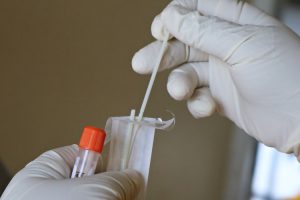Health
Study: Insurers May Using Drug Costs to Discriminate

In this photo taken Aug. 21, 2014 shows health care tax forms 8965, in Washington. (AP Photo/Carolyn Kaster)
KELLI KENNEDY, Associated Press
FORT LAUDERDALE, Fla. (AP) — Insurance companies, perhaps more than previously thought, may be charging the sickest patients extra for drugs under the federal health law, in an effort to discourage them from choosing certain plans, according to a study released Wednesday.
One of the cornerstones of President Obama’s signature health law forbids insurance companies from turning away people with pre-existing conditions such as diabetes or cancer. Yet hundreds of patient advocacy groups say insurance companies have found a way to discriminate against these people, who are more expensive to cover because they require life-long treatments.
The companies do this by putting all of their medications in a special category where the patient is required to pay a percentage of the cost of the drug, rather than a flat co-pay. Some are as high as 50 percent, leaving people on the hook for thousands of dollars. That compares to the average $10 to $40 per-medication co-pay that most pay.
A study published in the New England Journal of Medicine only examined HIV drugs, but noted the problem applies to mental illness, cancer, rheumatoid arthritis, diabetes and other chronic conditions. Patient advocates have complained that prescriptions for these patients were virtually unaffordable in some plans offered on healthcare.gov.
The AIDS Institute even filed a formal complaint with Health and Human Services officials last summer about four plans in Florida. Georgia plans to file a similar complaint, but the scope of the problem has been difficult to gauge as many of the complaints have been anecdotal.
The researchers studied 48 plans in 12 states using the federal marketplace: Delaware, Florida, Louisiana, Michigan, South Carolina, Utah, Illinois, New Jersey, Ohio, Pennsylvania, Texas, and Virginia.
They found that one-quarter of the plans placed all of the HIV drugs into the highest-cost category and required consumers to pay at least 30 percent of the drug costs instead of a flat co-pay. Annual drug costs in these plans were more than triple compared with other plans ($4,892 to $1,615), according to the analysis. And 50 percent had to pay a separate deductible for drugs, compared to only 19 percent of consumers in other plans.
Insurers have historically placed drugs in categories with higher co-pays to encourage consumers to select generic or preferred brand-name drugs. The problem is exacerbated as more plans place all drugs, including generics, in the more expensive category.
“Our findings suggest that many insurers may be using benefit design to dissuade sicker people from choosing their plans,” the study noted.
Over time, researchers predicted sicker people will enroll in plans that don’t charge such high prices. That means certain plans could have a higher number of sicker, more expensive consumers than their competitors. The federal law has financial protections for those plans but some will be phased out in 2016.
The law does ban insurers from charging an individual more than $6,350 in out-of pocket costs a year and no more than $12,700 for a family policy.
Insurance companies say the main issue is increasing drug costs and they’re shouldering the bulk of it. But they acknowledge the increased prices are also passed onto consumers.
For example, Atripla, the most popular HIV AIDS treatment and one of the highest-selling drugs in the U.S., costs insurers $27,026 a year. Patients only pay a portion of that, said Clare Krusing, a spokeswoman for the trade association America’s Health Insurance Plans.
But insurers noted consumers have the flexibility to choose from plans at all levels with different cost-sharing requirements and that the health law has a component that rewards plans for value and efficiency “not on their ability to attract healthier enrollees,” Krusing said.
Advocates have asked federal health officials to intervene and nearly 300 patient groups sent a letter last month urging Health and Human Services Secretary Sylvia Burwell to beef up enforcement. The federal government has warned against such discrimination.
“We analyze plan information submitted by insurance companies to uncover discriminatory benefit designs, and work with outlier plans to update formularies so they do not discourage enrollment of consumers with specific medical conditions,” agency spokesman Aaron Albright said in an email.
It’s unclear what the penalties are for insurance companies who discriminate.
Meanwhile, insurance officials in some states are stepping in. Three out of four insurance companies restructured their plans in Florida late last year.
Copyright 2015 The Associated Press. All rights reserved. This material may not be published, broadcast, rewritten or redistributed.
Community
Calif. Dept. of Public Health: Got Milk Allergies? Don’t Eat Dave’s Bakery Cornbread
The California Department of Public Health (CDPH) issued a warning on Jan. 26, instructing consumers with milk allergies or “severe sensitivity to milk” in the state to not eat Dave’s Bakery Corn Bread due to “risk of illness.” The CDPH warns that consumption of the corn bread manufactured by a Gardena-based company — with expiration dates up to June 18, 2024 — may lead to “life threatening” reactions.

By California Black Media
The California Department of Public Health (CDPH) issued a warning on Jan. 26, instructing consumers with milk allergies or “severe sensitivity to milk” in the state to not eat Dave’s Bakery Corn Bread due to “risk of illness.”
The CDPH warns that consumption of the corn bread manufactured by a Gardena-based company — with expiration dates up to June 18, 2024 — may lead to “life threatening” reactions.
“This warning applies only to the Corn Bread produced by Bake R Us, DBA Dave’s Baking Company and distributed to schools, retail facilities and in vending machines primarily in southern California,” the DCPH statement reads.
“This product should not be confused with other similarly named companies with national distribution,” it continues.
According to the CDPH, although the corn bread product contains whey, which is a milk allergen, there is no allergy warning label on the packaging, though it is required by state law.
So far, authorities say, no illnesses have been reported in the state, but if anyone finds the products on sale anywhere in the state, they should call the CDPH complaint hotline at (800) 495-3232 or file a report online at CDPH.ca.gov
The CDPH is also recommending that people who have eaten the product and are experiencing any reaction or ill effects should consult their health care provider.
Bay Area
East Bay Regional Park District Issues Rattlesnake Advisory
The East Bay Regional Park District released an advisory today on rattlesnakes, which emerge from winter hibernation in early spring and become more active. Warm weather can bring more potential for rattlesnake encounters with humans and dogs, particularly along trails and roads.

The Richmond Standard
The East Bay Regional Park District released an advisory today on rattlesnakes, which emerge from winter hibernation in early spring and become more active.
Warm weather can bring more potential for rattlesnake encounters with humans and dogs, particularly along trails and roads.
Visitors are encouraged to avoid hiking alone in case of an emergency, to scan the ground ahead as they walk, jog or ride, stay on trails avoiding tall grass, and to look carefully around and under logs and rocks before sitting down. Keep your dog on your leash to be extra safe, park officials said.
If you encounter a rattlesnake, leave it alone – it is unlawful to capture or harm one. Move carefully and slowly away or around it and give it plenty of space, park officials said.
Those who are bitten by a rattlesnake are instructed to stay calm by lying down with the affected limb lower than the heart, then having someone call 911.
Getting medical attention is critical.
Those bitten should not use tourniquets, “sucking,” or snake bite kits. If you are by yourself, walk calmly to the nearest source of help to dial 911, do not run.
If bitten by any other type of snake, wash the wound with soap and water or an antiseptic and seek medical attention.
Not sure what bit you? Check the bite for two puncture marks (in rare cases one) associated with intense, burning pain, which is typical of a rattlesnake bite. Other snakebites can leave marks without associated burning pain.
The Northern Pacific rattlesnake is the species found in East Bay Regional Parks. Snakes are important to the natural environment, helping to control rodents and other reptile populations. But enjoy them from afar.
For more information, download the Park District’s Common Snakes brochure or watch our Gopher Snake or Rattlesnake video to learn how to tell the difference between rattlesnakes and gopher snakes. Additional information is available at ebparks.org/safety/wildlife-encounters.
Alameda County
A Safe Place, Bay Area Domestic Violence Community Organization, Opens New Service Center in Oakland
Oakland-Bay Area non-profit, A Safe Place, announces the grand opening of its newly purchased building in Oakland that will be a service center for families that have suffered from domestic violence. The new, two-story building has over six new service rooms for counseling, mental health support groups, legal services, children’s treatment, safe space for community engagement, and partnership activities.

By Courtney Slocum Riley
Special to The Post
Oakland-Bay Area non-profit, A Safe Place, announces the grand opening of its newly purchased building in Oakland that will be a service center for families that have suffered from domestic violence.
The new, two-story building has over six new service rooms for counseling, mental health support groups, legal services, children’s treatment, safe space for community engagement, and partnership activities.
Domestic violence occurrences and offenses account for a considerable amount of all violent crimes in Alameda County. A Safe Place is attempting to provide a safe place for families to heal. A Safe Place is the only comprehensive domestic violence assistance program including a safehouse, in Oakland.
The grand opening celebration will also serve as a fundraiser to build out healing, therapeutic spaces for children and adult victims and survivors and survivors of domestic violence (male and female).
The new service center will expand the work of the organization, founded in 1976 when a group of women working in San Francisco came together to address the urgent need for a shelter in the East Bay. A year later, they founded A Safe Place (ASP) in Oakland. Run solely by volunteers, they set up a crisis line to offer crisis counseling and information to battered women and their children.
The organization serves over 500 adults and children annually through a host of services including crisis counseling via 24-hour crisis line, emergency motel and safehouse sheltering, mental health services (counseling and support groups).
Under the leadership of Executive Director, Carolyn Russell, the organization has grown from a single program into the comprehensive domestic violence and assistance program. ASP strives to meet the growing and diverse needs of our growing community.
The organization hopes to complete all the upgrades and therapeutic room improvements by August 2024. The public is invited to donate to the effort by using the website at www.asafeplace.org/donate. The organization also accepts in-kind gifts as well as items from the organization’s Amazon Wishlist.
-

 Community3 weeks ago
Community3 weeks agoFinancial Assistance Bill for Descendants of Enslaved Persons to Help Them Purchase, Own, or Maintain a Home
-

 City Government6 days ago
City Government6 days agoCourt Throws Out Law That Allowed Californians to Build Duplexes, Triplexes and RDUs on Their Properties
-

 Activism2 weeks ago
Activism2 weeks agoOakland Post: Week of April 24 – 30, 2024
-

 Business3 weeks ago
Business3 weeks agoV.P. Kamala Harris: Americans With Criminal Records Will Soon Be Eligible for SBA Loans
-

 Activism4 weeks ago
Activism4 weeks agoOakland Post: Week of April 10 – 16, 2024
-

 Community3 weeks ago
Community3 weeks agoAG Bonta Says Oakland School Leaders Should Comply with State Laws to Avoid ‘Disparate Harm’ When Closing or Merging Schools
-

 Community3 weeks ago
Community3 weeks agoRichmond Nonprofit Helps Ex-Felons Get Back on Their Feet
-

 Community3 weeks ago
Community3 weeks agoOakland WNBA Player to be Inducted Into Hall of Fame























































